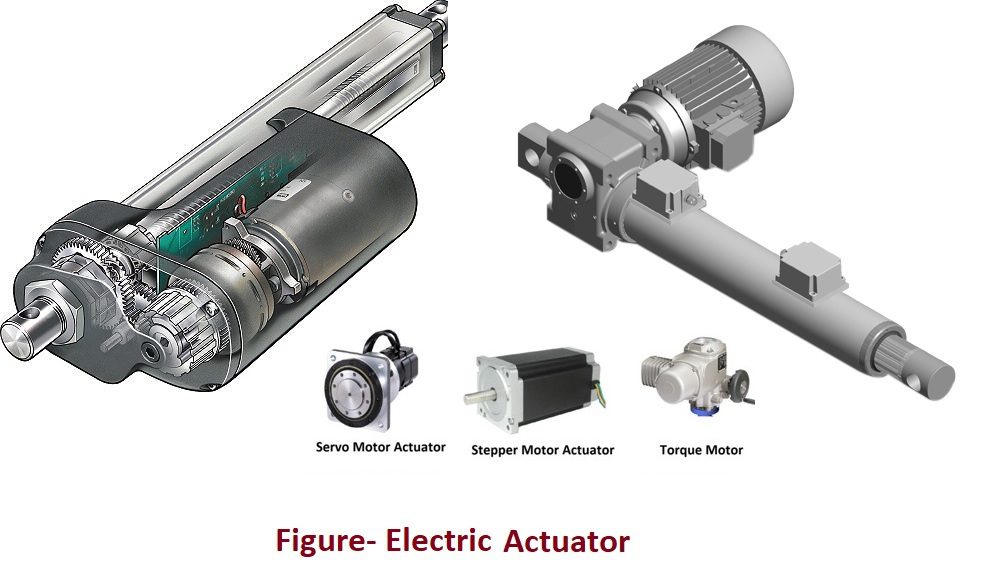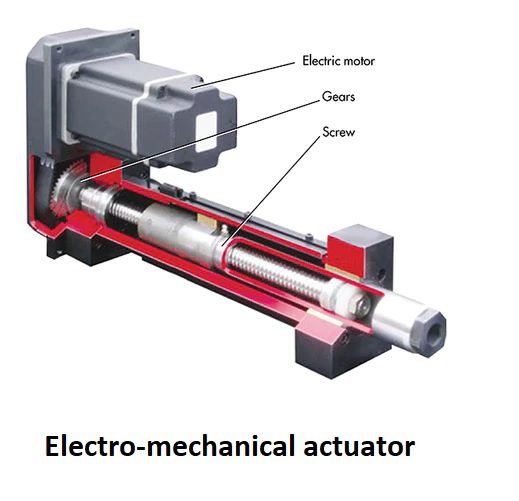Table of Contents
An actuator is a device that delivers a force or motion by converting source energy according to the control signal received. Here source energy can be pneumatic, hydraulic, or electric type and motion produced (by the actuator) can be either linear or rotary. There are various types of actuators available in a real-world applications. There can be various methods for actuators categorization or classification. Type and classification can be based on their design, applied source of energy, type of motion delivered by it, etc. as mentioned below-

Linear actuator
A linear actuator is an actuator that basically delivers motion in a straight line in response of received control signal. They are used in a wide range of industrial applications where linear positioning is needed. Linear actuators can be either manual operated or powered by some energy source such as compressed air, fluid pressure, electrically powered. Pneumatic or hydraulic piston cylinders, diaphragm mechanism provides linear motion directly. Besides that, circular motion of a conventional motor can also be used to generate linear motion using some geared or threaded mechanism. Linear actuators are also referred as sliding stem actuator and used in machine tools, industrial machineries, process control valves and dampers, in computer peripherals such as disk drives and printers, and in so many other places. Linear actuators can be various types as mentioned below-
- Manual Linear Actuator
- Pneumatic Linear Actuator
- Fluid Powered Linear Actuator
- Electric Linear Actuator
- Linear Chain Actuator
- Solenoid operated linear actuator
Different linear actuator’s configurations are mentioned below-





Rotary actuator
A rotary actuators are another types of actuators that basically deliver circular or rotary motion or torque in response of received control signal. They are used in a wide range of industrial applications where rotary positioning is needed. Rotary actuators can be either manual operated or powered by some energy source such as compressed air, fluid pressure, electrically powered. Mostly electrical motors are used for rotary actuator operation. Here rotary motion produced by an actuator may be either continuous rotation of electric motor or movement to a fixed angular position as for servomotors and stepper motors. Besides that, linear motion from cylinder piston can also be used to generate rotary motion using some geared mechanism. Rotary actuators can be classified as mentioned below-
- Manually operated rotary actuator
- Pneumatic rotary actuator
- Hydraulic rotary actuator
- Electric motor actuator
- Stepper Motor actuator
- Servo motor Actuator
- Torque motor
Different rotary actuator’s configurations are mentioned below-





Mechanical actuators
A mechanical actuator are such types of actuators that functions to execute movement by converting one kind of motion, such as rotary motion, into another kind, such as linear motion. An example of mechanical actuators is a rack and pinion. Such actuators also provide linear displacement through the translation of manually rotated screws or gears or can have hand-operated knobs or wheels, gearboxes, and guided motion mechanisms. So the operation of mechanical actuators is based on combinations of structural components, such as gears, screw, threaded rods and rails, or pulleys and chains. A diagram for different mechanism used for mechanical actuators are shown below-





Pneumatic actuator
Pneumatic actuators are such actuators that convert the energy of compressed air or gas into a mechanical motion that regulates a final control element according to the control signal received. Pneumatic actuators are known for highly reliable, efficient, and safe sources of motion control. A Pneumatic actuator mainly consists of a diaphragm or a piston enclosed by a casing and a stem connected to the diaphragm or piston which can be linked to a valve stem via coupling. Pneumatic actuators can have either one pneumatic signal port along with spring return mechanism which is referred as single acting actuator or can have double pneumatic signal port which is referred as double acting actuator. Typically in industries, pneumatic systems utilize air pressures of (80 to 100) PSI for their operation. When a controlled signal pressure is fed to port, air pressure forces the diaphragm or piston to move the valve stem or rotate the valve control element. These actuators are so popular in process control units such as refineries, petrochemical plants, power plants, gas industries, pharma industries, & fertilizer plants and other chemical industries etc. Various types of pneumatic actuators are shown below-





Hydraulic actuator
Hydraulic actuators are those actuators which uses hydraulic signal or fluid (mostly oil) pressure to move a valve mechanism i.e. controlled hydraulic oil pressure is used to force a piston rather than a diaphragm against mechanical spring or balancing pressure which results mechanical action or valve stroke. Thus high pressure hydraulic oil is applied to piston to convert fluid pressure into mechanical force. Here hydraulic fluid (oil) used for actuators are non-compressible in nature & its lubricating property helps to overcome the friction problem of piston-type actuators. Hydraulic oil pressure can be generated by a electric motor driven pump connected through a oil reservoir. The oil pressure can be used up to 400 bar (6000 PSI). Hydraulic actuators are used for extremely large force application. A hydraulic actuator is given below-





Electric actuator
Electric Actuators are such actuators that convert electricity into kinetic energy and deliver force or torque to create movement of mechanical load in response of received control signal. Electric actuator basically produces rotary motion because of use of electric motor. Some standard electrical voltage or current supply is used for their operation. Here electric motors may provide continuous rotation or a fixed angular position change. There are different configuration based on type of motor used and application as mentioned below-
- Electric motor actuator
- Stepper Motor actuator
- Servo motor Actuator
- Torque motor
Some standard electric supply used are- 24VDC, 110VDC, 110 VAC, 230VAC etc. Electric actuators are used for large valve application such as damper and guide vanes. Such valve applications along with electric actuators are referred as motor operated valves (MOV). Some different electric actuators are mentioned below-





Piezoelectric actuator
Piezoelectric actuator is basically a transducer that converts electrical energy into a mechanical displacement or stress and works based on piezoelectric effect. The basic principle of piezoelectric effect defines as when a force is applied to the crystal, it produces electrical charge. This is reversible phenomenon i.e. when a voltage is applied across its surface, crystal start deforming or vibrating. The reverse concept is utilized for piezo-actuators. Piezo Actuators have ability to change shape when a voltage is applied can be used to displace objects i.e. this basically allows electrical energy to be converted to mechanical energy. They are used to control small mechanical displacement at very high speed as well as in so many applications where accurate or precise position control is desired such as in robotics. They are also used to control hydraulic valves which work like a special-purpose motor, small-volume pump & in other applications. Diagram of some piezoelectric actuators is shown below-





Magnetic actuator
Magnetic actuators are such actuators which uses magnetic effect and magnetic properties to generate force and displacement. They can be both the types- linear type and rotary type which can deliver continuous motion or limited motion (Discrete motion). There are a broad range of magnetic actuators available which can be classified based on their principle and application as mentioned below-
- Moving coil actuator
- Moving magnet actuator
- Moving iron actuator
- Magneto-strictive actuator
- Magneto Rheological Actuator
- Electric Motor actuator
- BLDC motor actuators
Magnetic Actuators are having wide range of applications in industrial plants, process plants, aerospace, automation sector, healthcare etc. a diagram of magnetic actuators is given below-





Thermal actuator
Thermal Actuators are basically non-electrical types of actuators which thermal energy into kinetic energy. They are used to transform thermal energy into force, motion or stroke in response to temperature changes. There are several other mechanisms behind working of thermal actuators. A typical thermal actuator consists of a temperature sensing material which produces expansion or contraction according to change in temperature along with a piston that delivers force or motion in guided portion. Another mechanism may have temperature sensing fluid sealed within housing by a diaphragm that pushes against a plug to move a piston. Some applications of thermal actuators are-
- Thermal bypass valves,
- Thermostatic mixing valves,
- Tempering valves and
- Thermostatic balancing valves, etc.
A diagram for thermal actuator is given below-





Other Actuators
There is various other types of actuators i.e. electro converting that can be classified as following-
- Electro-pneumatic Actuator
- Electro-Hydraulic Actuator
- Electro-mechanical Actuator
- Electromagnetic actuator
Electro-pneumatic Actuator-
Electro-pneumatic actuators are such actuators in which pneumatic systems are controlled by electric signal. It is a best combination of electric and pneumatic system integrated to work as a single device. Electro-pneumatic actuator basically consists of an electronic positioner along with a pneumatic actuator. They are best suitable for low power applications. In almost all process plants and industries, they are so popular because they can be easily modified according to the requirement and we are able to control such actuators directly with an electronic control system. A diagram of electro pneumatic actuator is shown below-





Electro-Hydraulic Actuator
Electro-hydraulic actuators are such actuators in which hydraulic system is operated by electric power. It is a combination of electric and hydraulic system integrated to work as a single device. Electro- hydraulic actuator eliminates the need for separate hydraulic pumps and tubing since they are having their own hydraulic pump. It provides compact and simplify system design and improved safety and reliability. These actuators are used in many industries such as aerospace where hydraulic power is commonly used. A diagram of electro hydraulic actuator is shown below-





Electro-mechanical Actuator
Mechanical actuators when operated using electrical power, it is referred as electro-mechanical actuators. Electromechanical actuators are such mechanical actuators where the control knob or handle has been replaced by an electric motor and the rotary motion of the motor is converted into linear displacement. The simplified design uses various mechanisms to transfer motor motion into linear displacement. A diagram showing electro-mechanical actuator is shown below-





Electromagnetic actuator
Electromagnetic actuators are such actuators that work based on principle of electromagnetism and transform electrical energy into magnetic form then into mechanical force or motion. The fundamental laws behind working of electromagnetic actuators are as follows-
- Faraday’s laws of electromagnetic induction.
- Lorentz force of electromagnetic forces.
- Biot-Savart’s Law.
In such actuators electric field and magnetic field both involve to deliver force or motion. An example of electromagnetic actuator is solenoid valve. A diagram of such actuator is given below-





To read more click here-
What Is control Valve?
comparison between Sensor Vs Actuator